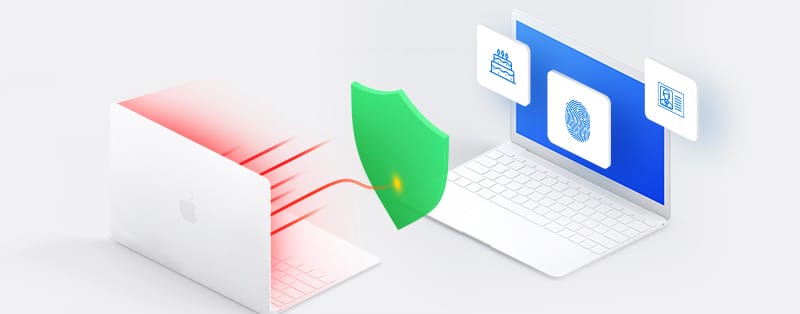5 Ways to Prevent Identity Theft Online

Many people spend a good number of hours online daily; although this might seem like a good thing, it comes with a few drawbacks. In a world where security challenges have been rising, identity theft is a massive emerging issue in cyberspace. So we should be informed about how to keep our personal information safe.
When your connection or data is compromised, the snoop takes over and controls the affairs of your connection, account, or information to the benefit of his pocket. For the most part, cases like this always end up being detrimental to the identity owner (you). We put this piece together to help you avoid becoming a victim of online identity thieves.
Scammers are always creating new ways to steal sensitive information for their financial gain. This article sheds light on the precautionary measures for identity theft and what to do if your identity has been compromised.
What Is Online Identity Theft?
Online identity theft is when a scammer uses your data (name, ID number, license, birth date, home address, etc.) to impersonate you for his financial gain. These cybercriminals can even take advantage of present situations, like pandemics, to rip people. Since they are criminals, they do not care what it does to victims.
Scammers can use the stolen information to empty your bank account(s), get access to your investment returns, request donations from your family (in your name), or even frame you for a crime to save themselves or their friends. If any crime wasn’t involved in the first instance, if the person that stole your identity commits a crime, it’ll be on you.
Sometimes, the consequences are subtle, and you might still have enough access to your compromised account to regain control. On the other hand, they can log you out, change your login details, and take absolute control of your funds. Sometimes, the scammers contact the victim to pay them to release the account back to him; it’s all about the money for most of them.
Types of Identity Theft
To many people, identity theft ordinarily sounds like stealing bank information to access funds. However, there are several other types apart from that. To protect yourself from possible attacks, you have to know what these attacks are specifically.
1. Financial Identity Theft
Financial identity theft is easily the most common of all types. In this case, the thief will look to make purchases, empty the bank account, or even secure a loan using the victim’s identity. Apart from the fact that the victim will be the one to pay the loan, he might not get a loan in the future. Also, identity thieves can get your tax refund when they obtain your information.
2. Criminal Identity Theft
Even though this type of theft is rare, it exists. Usually, the identity thief here has committed a crime, so he tends to give false information when he’s arrested. These people get government-issued ID documents stolen from someone or create a fake ID, so the theft victim takes the fall for it, and the thief runs free.
It is always challenging to clear your name if you fall victim, and most times, you might have to get the officers that initiated the arrest to identify that you were not the one they arrested. Overall, it takes a robust sacrifice of time and money for the victim to clear his name.
3. Synthetic Identity Theft
In this case, the thief fabricates identities either entirely or partially. In real essence, he pulls resources (in the form of serial identity number, name, birth date, photo, address, etc.) from different individuals to create a new virtual identity. Nobody can be singled out in this case, but the persons with the details used will be affected.
Common Ways Identity Theft Occurs
This section highlights some of the ways identity thieves can compromise your personal information.
1. Lost Wallet
People try to keep valuables in one place, and a wallet happens to be one of those places. If you lose such a wallet, the person who finds it automatically gains direct access to all the information in it. That means your privacy and security might be found wanting.
2. Using Public Wi-Fi
When you connect to a public Wi-Fi, hackers can infiltrate the connection and gain access to essential details that they can use to steal your identity.
3. Data Breaches
Whether you like it or not, some organizations and agencies (government, internet service providers, health, and other private sectors) have your data with them. Hackers can invade their database and gain access to information that can compromise your identity. In this case, almost everyone, if not all, is affected.
4. Phishing and Phone Scams
With phishing attempts, fraudsters send you a corporate email, fake official text messages, or calls requesting personal information. It is easy to fall for it because it appears valid. They could call to tell you you’ve won something, and ask you to send some personal information to claim your prize and for them to deliver it. It’s a scam!
5. Skimming and Malware Attacks
Using a small device, identity thieves can retrieve your credit card details and your PIN after you’ve left the gas station or an ATM. On the internet site, cybercriminals use a keylogger to record every input to gain access to your data.
How to Prevent Identity Theft Online
Here, we pulled some precautionary measures together to help you stay ahead of the curve against identity theft.
1. Secure necessary documents and shred unwanted documents
Since you won’t be needing documents like your birth certificate and your voter’s card very often, it is only safe to lock them up in a safe box at home. Also, you can secure digital documents by installing the encryption software. Furthermore, it is safer to shred documents you don’t need again (like bank statements and bills) rather than throwing them in the bin.
2. Lock! Lock! Lock!
If an identity thief gets a hold of your phone, it’s going to be a massive bingo hit for him because your phone has almost everything pertaining to you. That is why you need to use a very solid password and not just a pattern swipe or a four-digit PIN. Most importantly, use a two-factor authentication system for added security. Overall, you can use a biometric lock to ensure your device or apps cannot be accessed without you. Lock up!
3. Install Protection
Your PC needs a robust antivirus software package. It gives you protection against all sorts of viruses, malware, and potential phishing attempts. There is also utility software that can lock your stolen device and even help you to recover it. Also, a Virtual Private Network (VPN) could be useful for that course. A VPN even comes with a bonus of giving you maximum protection when you’re connected to public Wi-Fi.
4. Avoid Oversharing
When you post your pictures, location, or even destination on social media, you might be easing an identity thief into infiltrating your privacy. Also, avoid dropping your bank account details under posts that claim to do “giveaways” on online platforms. It puts you at risk of identity theft from prying eyes.
5. Be Careful
You have no power over it — Cyber crooks will make phishing attempts and try to trick you into giving them sensitive information. But it is up to you to provide them with or evade their attack. Always verify the authenticity of email and website requests. You can visit the institution itself to confirm. Also, be sure to check that no one is peeping while you input your password or PIN.
What to Do If Your Identity Has Been Stolen
There are three necessary steps you should take immediately you realize your identity has been stolen. These steps can either help you retrieve your identity from the thief or make it impossible for the criminal to use it.
1. Change Passwords of Affected Account Passwords
The very first step is to attempt to login into the account that may be compromised. If you can log in successfully, change the password and log the identity thief out before he gets the chance to do it to you. Make sure you secure other accounts against potential attacks.
2. Notify Companies of Your Stolen Identity
You must contact the concerned organization (bank, insurance, or government institution) to report the case of your stolen identity. You can request that they block your credit and debit cards or even freeze your account, depending on the modalities of the agency involved.
3. Contact Your Local Police Department
You can’t tell if the thief will be using your identity to commit a crime, so you must file a report with your local police department in a bid to protect yourself.
Conclusion
Even though the preventive measures we discuss in this piece might not be enough to ward off targeted attacks, you’ll be safe from random theft attempts. Note that the five protective measures are valid because identity thieves sought after readily susceptible persons. Meanwhile, with the “big five,” you can be sure of standard protection.
